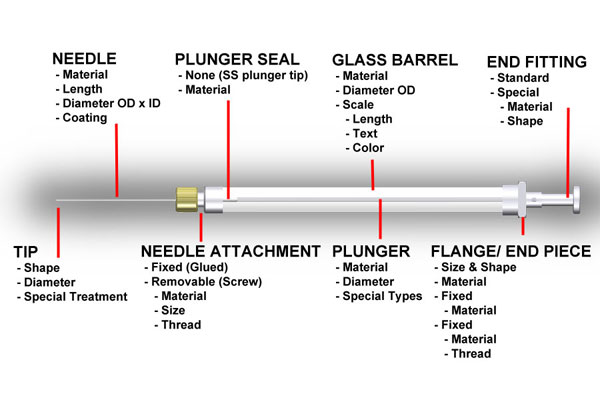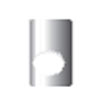Technical Information for ILS Glass Microsyringes
For more information about glass syringes for HPLC, GC, Automated Liquid Handling, or manual usage, visit our online SYRINGE CATALOG, or Contact Us and request a catalog.
Syringe Quality from ILS
All ILS syringes are manufactured at our manufacturing facility in Germany from high quality DURAN® Borosilicate 33 Type I expansion glass. The 33 expansion glass is the highest chemical resistance and lowest expansion glass that is used for syringe manufacturing and produces the best precision and calibration. All PTFE and metal parts are designed and manufactured in-house using state of the art computer-controlled milling and lathing machines and specialized glass shrinking equipment.
ILS uses a unique process to apply the label markings to the glass barrel. The markings are screen-printed with silver ink and then heated. A chemical exchange occurs between the boron in the glass and the silver to etch the unique brown-colored markings that will not wash off, rub off, or fade over time.
![]() ILS Certificate of Conformance (SAMPLE)
ILS Certificate of Conformance (SAMPLE)
![]() ILS Certificate of Calibration (SAMPLE)
ILS Certificate of Calibration (SAMPLE)

Parts of a Syringe & Selecting a Syringe
The glass microsyringe is one of the most commonly used items in science laboratories of all types. There are many different syringe models available to address the hundreds of different applications this precision tool is used for. All syringes begin with a high-quality glass barrel, then the other parts are constructed as needed for each use. The syringe catalog helps to direct you to the specific syringe you need either by type or by application.

Because ILS produces all parts of all syringes in our own manufacturing facility we are able to manufacture virtually any syringe configuration that you require. You can build your own syringe with the needle, plunger, barrel, and end fittings that will best suit your needs. If you require a custom syringe you may complete the Syringe Questionnaire, or Contact Us for help.
![]() ILS Custom Syringe Questionnaire
ILS Custom Syringe Questionnaire
Using the Syringes
- Prime the syringe approximately 10 times with the same liquid used for the application.
- For the best accuracy, the volume should be greater than 10% of the syringe maximum volume.
- To prevent cross-contamination and carryover, rinse the syringe 10-20 times with solvent and don’t forget to put the first 2-3 rinsing steps into waste.
- Do not force the plunger, and do not repeatedly move the plunger while the syringe is dry or if the needle is clogged.
- For the H Series syringes with plunger seals, it is especially important to minimize the movement of the plunger while the syringe is dry. This can cause abrasion of the seal material and will shorten the lifetime of the syringe.
- Check the syringe for any cuts or cracks and whether the tip of the syringe needle shows any damage such as a burr which can cause damage to septa. These particles can clog the tip or can enter the chromatograph or column and can influence your results.
Temperature Range and Autoclaving Syringes
- The temperature range for standard ILS syringes is up to 150°C. Exposure to high temperature should be limited as follows:
- 150°C for 15 minutes
- 120°C for 30 minutes
- 110°C for 60 minutes
- If extra high temperatures are required, ILS will provide special-order syringes with glue that is compatible up to 225°C continuous or 325°C intermittent.
- All syringes can be autoclaved except fixed needle syringes. Because the fixed needles are permanently glued to the glass barrel, these syringes will crack due to thermal expansion when autoclaved. For all other syringes simply remove the plunger and the removable needle (if applicable) before autoclaving.
Syringe Cleaning
After use:
- Clean the syringe thoroughly, preferably in an ultrasonic bath.
- Wipe the plunger with a non-fibre shedding cloth, holding it by the handle.
- Flush syringe with acetone or methanol and dry with pressurized air or vacuum.
- Do not completely immerse the syringe in organic solvent, as this may attack some of the materials.
- Only insert plunger when the syringe is completely dry. Do not move the plunger unnecessarily while it is dry.
Troubleshooting Syringes
- To remove an air bubble, aspirate the sample and then dispense it quickly by keeping the tip in the liquid. Alternatively, you can turn the syringe upside down so that the tip is at the top and the air bubbles move to the top. Then you can release the air bubbles by dispensing a bit of the sample.
- H Series syringes with PTFE plungers can become difficult to move due to the high expansion coefficient of the PTFE. In this case place them in a 60°C oven for 5-10 minutes and the plunger should move more freely.
- If the plunger becomes very difficult to move, it is likely due to a clog in the needle. The needle should be cleaned or replaced. ILS syringes are delivered with a cleaning wire for the needle, be sure to keep it so you can use it when necessary.
- Damaged plungers in syringes used in autosamplers are usually caused by incorrect mounting or adjustment. Be sure that the syringe is correctly installed in the HPLC or GC autosampler or other liquid handling instrument.
- N Series syringes with metal plungers cannot have the plungers replaced; each plunger is matched to each syringe.
- H Series syringes with plunger seals can sometimes have the plunger replaced, depending on the style and volume of the syringe.
| Needle | Description |
Needle Tip "A" |
|
Needle Tip "B" |
|
Needle Tip "C" |
|
Needle Tip "D" |
| Gauge | O.D. mm | I.D. mm |
| 33 | 0.20 | 0.11 |
| 32 | 0.25 | 0.11 |
| 30 | 0.30 | 0.15 |
| 29 | 0.35 | 0.15 |
| 27 | 0.40 | 0.20 |
| 26 | 0.45 | 0.25 |
| 26s | 0.47 | 0.13 |
| 25 | 0.50 | 0.28 |
| 24 | 0.55 | 0.32 |
| 23 | 0.64 | 0.35 |
| 23s | 0.64 | 0.15 |
| 22 | 0.72 | 0.40 |
| 22s | 0.72 | 0.20 |
| 21 | 0.80 | 0.50 |
| 20 | 0.90 | 0.60 |
| 19 | 1.10 | 0.70 |
| 18 | 1.30 | 0.90 |
| 17 | 1.50 | 1.10 |
| 16 | 1.70 | 1.20 |
| 15 | 1.80 | 1.40 |
| 13 | 2.40 | 1.90 |
| 12 | 2.80 | 2.20 |
| 11 | 3.00 | 2.40 |
| 10 | 3.40 | 2.70 |
| Type | Description |
 |
Fixed Needles. The needle is permanently attached to the glass barrel with glue. Not autoclavable. This design has the least carryover. |
 |
Removable Needles. The needle can be removed by unthreading. This allows the needle to be replaced if desired due to damage. |
| Type | Description |
 |
Screw thread 1/4"x28 UNF. Also called "C" and CX" type. |
 |
Screw thread 1/4"x28 UNF. |
 |
Screw thread M10. |
 |
Screw thread M8 x 0.75. Also called "AD" type. |
 |
Screw thread M8 x 0.75 with side connection internal threads M6 x 1. . Also called "DAD" type. |
 |
Screw thread M10. |
 |
Luer connection with side connection internal threads M6 x 1. Also called "D" type. |
 |
Luer connection PTFE. Also called "TLL". |
 |
Luer connection, glass taper. |
 |
Luer connection, PTFE taper. |
 |
Tubing connector, available either with Mx or 4x28 threads. |
| Type | Description |
| Type N Stainless Steel |
Stainless steel plunger for general purpose operation with liquids. Plunger is matched to the barrel and cannot be interchanged. |
| Type N Titanium Nickel |
Super flexible plunger is very resistant to bending and also resistant to salt buffers. Plunger is matched to the barrel and cannot be interchanged. |
| Type H Stainless Steel |
Stainless steel plunger with seal attached to the end, suitable for liquids and gases. Also called "gas-tight". The standard seal material is PTFE. Other seal materials may be specified (see below). On most models the seal can be replaced and the plunger can be replaced if necessary. |
| Material | Description |
| PTFE virginal | Standard Teflon seal for high chemical resistance. It is low wetting and has good gliding characteristics. It will expand at higher temperatures. |
| PTFE modified | Teflon with lubrication for lower friction and longer lifetime for automatic liquid handling. |
| PE HD | High density polyethylene for better durability with high salt concentration buffers. |
| PTFE special black | New material from ILS has even less friction, less high-temperature expansion, and less electrostatic charge than virgin PTFE and maintains high chemical resistance. It has less cold flow and will provide the highest robustness and longevity. Add "bl" to the part number to order a syringe with the PTFE black seal. |
| Type | Description |
 |
Standard knob. |
 |
Similar to the standard knob, but has internal 6-32 UNC threads in the top to allow attachment via a screw. A set screw on the side allows it to be locked. |
 |
Has internal 6-32 UNC threads in the top to allow attachment via a screw. A set screw on the side allows it to be locked. |
 |
Has internal 6-32 UNC threads in the top to allow attachment via a screw. |
 |
Plunger top with mounting hole. Also called "XL" type. |
 |
Plunger top with mounting hole and knurled screw. |
 |
Tapered plunger top with mounting hole and knurled screw. |
 |
Plunger top, ball style. Also called "XE" style. |
 |
Plunger top, indented style. Also called "XP" style. |
| Volume | psi | MPa | bar | |
| 50 ul | OD 8 mm | 1500 | 10.8 | 108 |
| 100 ul | OD 8 mm | 1400 | 9.7 | 97 |
| 250 ul | OD 8 mm | 1100 | 7.7 | 77 |
| 500 ul | OD 8 mm | 800 | 5.8 | 58 |
| 1.0 ml | OD 8 mm | 500 | 3.7 | 37 |
| 2.5 ml | Wall thickness 1.5 mm | 300 | 2.3 | 23 |
| 5.0 ml | Wall thickness 1.5 mm | 200 | 1.7 | 17 |
| 10.0 ml | Wall thickness 1.5 mm | 180 | 1.3 | 13 |
| 25.0 ml | Wall thickness 2.0 mm | 150 | 1.1 | 11 |
| 50.0 ml | Wall thickness 2.0 mm | 115 | 0.8 | 8 |
| 100.0 ml | Wall thickness 2.0 mm | 115 | 0.8 | 8 |